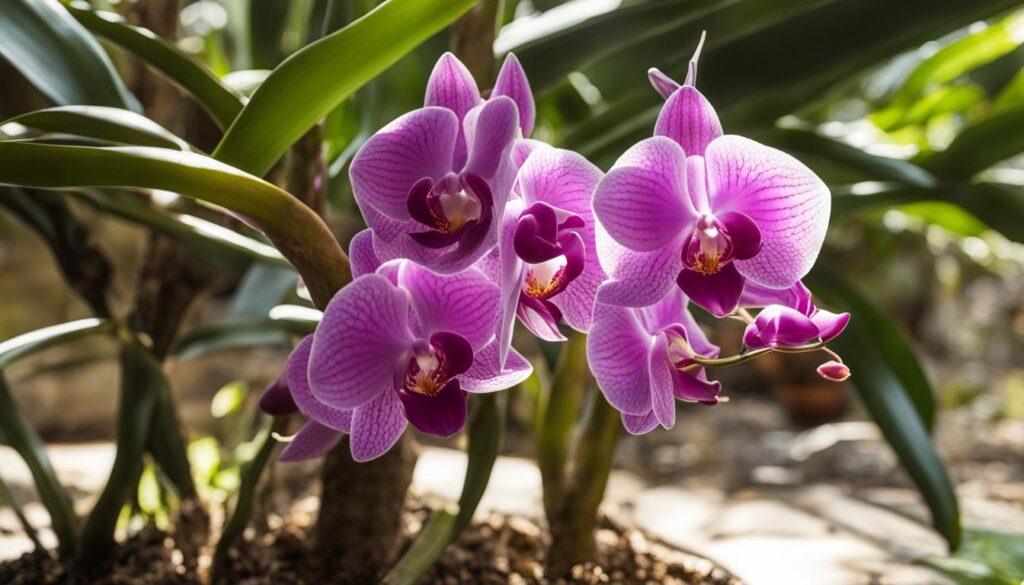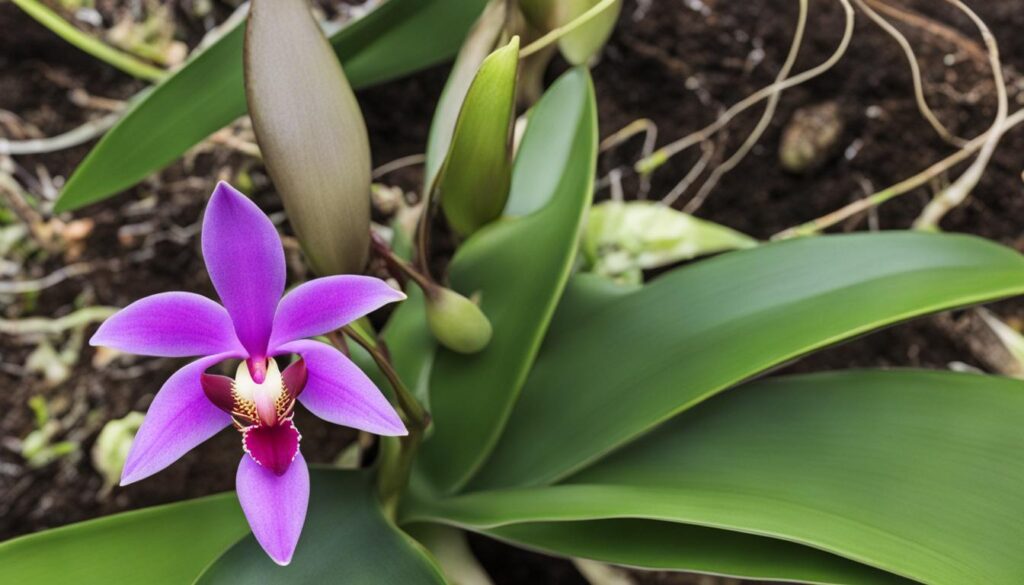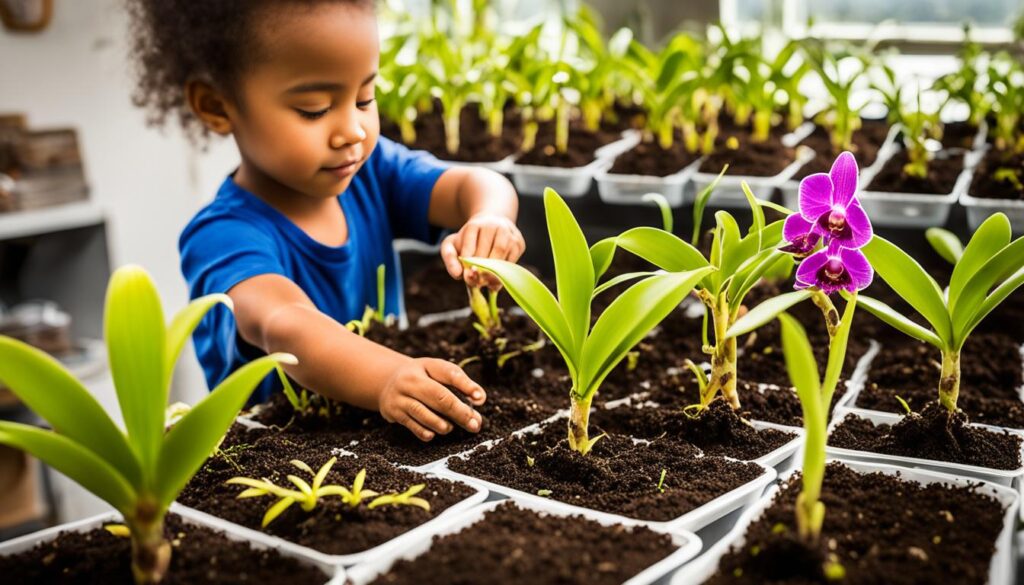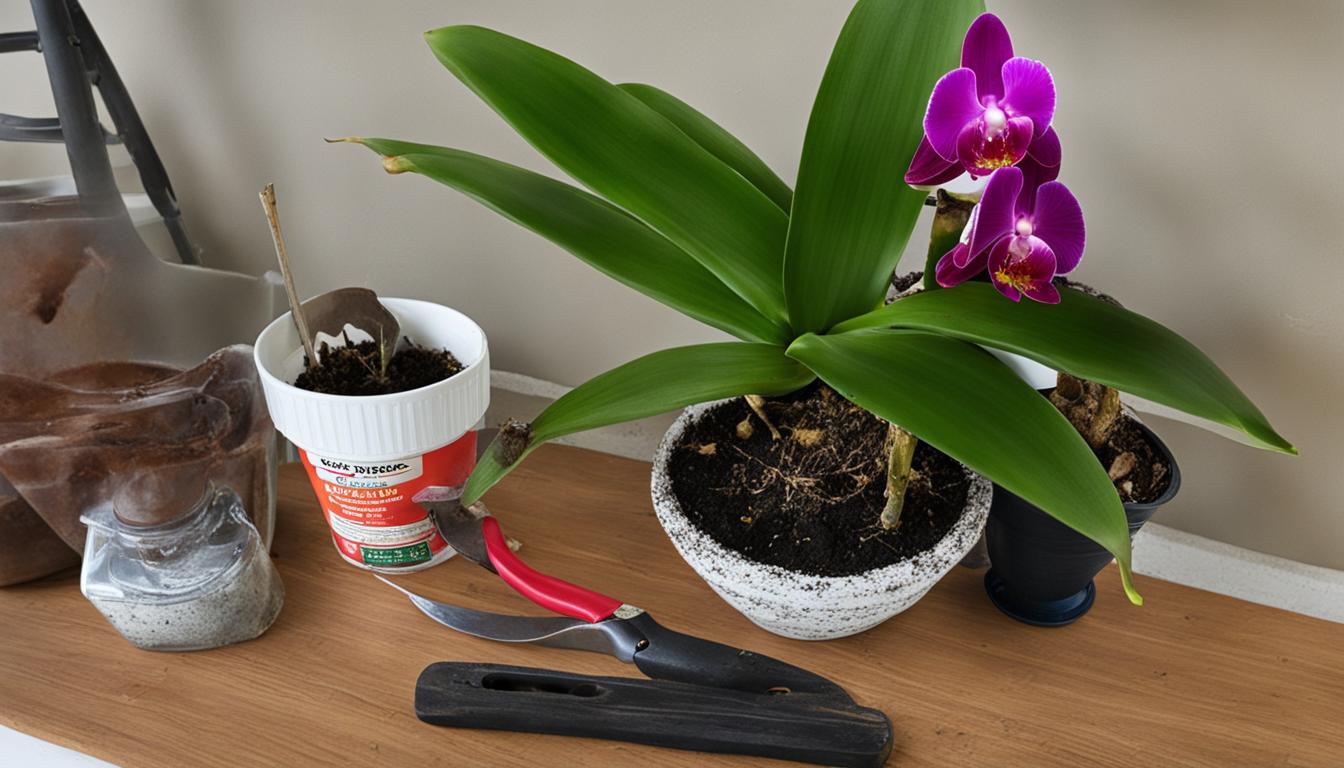As an avid orchid enthusiast, I’ve come to understand the nuances of orchid keiki growth and the importance of meticulous orchid plant care. Observing the emergence of a keikim those plucky offshoots of the parent plant, is a thrilling moment that represents the success of careful cultivation.
Keikis, serving as a testimony to effective orchid propagation, are fascinating to nurture. I’ve found that each keiki holds the promise of a new beginning and that guiding them through their tender growth phase is both art and science.
Here, let me share insights on how to promote keiki growth in orchids, ensuring they thrive and eventually contribute to the spectacular orchid legacy.
Key Takeaways
- Identifying a keiki early on is crucial for targeted orchid care.
- Providing the right environment is essential for keiki development.
- Understanding when and how to separate a keiki influences successful propagation.
- Regular monitoring and adjusting of humidity and temperature support keiki health.
- Fostering a keiki’s growth involves not just care, but patience and observation.
- Mitigating stress and ensuring proper nutrition are keys to vibrant keiki growth.
Understanding Orchid Keiki Development
Within the lush foliage of a well-tended orchid collection lies the potential for a new life in the form of what are known as ‘keikis’.
My fascination with nurturing these orchid keikis extends beyond mere curiosity; it’s about perpetuating the natural wonder that nature inexorably insists upon.
As you, the reader, embark on this journey with me, let’s dive deep into the remarkable process of encouraging orchid keikis and uncover valuable orchid keiki care tips that will ensure the prosperity of these exotic progenies.
Defining ‘Keiki’: What Your Orchid Baby Means
Deriving from Hawaiian vernacular meaning ‘the little one’, a keiki is essentially a clone of its parent plant, promising the very same spectacular blooms.
I embrace the mission of nurturing orchid keikis, being attentive to their needs, and providing conditions that not only promote new growth in orchids but celebrate the plant’s ability to regenerate in this unique manner.
Signs and Symptoms: When Your Orchid Is Preparing to Propagate
Attuned to the nuances of orchid care, I’ve come to recognize the telltale signs that an orchid keiki is on the horizon.
It’s thrilling to spot the miniature roots and leaves signaling that my efforts in encouraging orchid keikis are bearing fruit.
Monitoring these developments is as rewarding as it is crucial to the propagation process.
Genetic Cloning Naturally: The Science Behind Keiki Growth
The mystique of orchid propagation unfolds in my garden as I witness the natural genetic cloning that keikis embody.
Pivotal to species survival, this occurrence is as scientifically fascinating as it is visually captivating.
Ensuring that these orchid babies mature healthy and strong becomes a practice that melds art with the precision of science.
| Care Element | Description | Impact on Keiki Growth |
|---|---|---|
| Lighting | Filtered, bright light without direct sun exposure | Promotes healthy foliage and root development necessary for keiki maturation |
| Temperature | Daytime around 75°F (24°C) and nighttime drops of approx. 10–15 degrees | Facilitates keiki growth by mimicking their natural tropical habitat |
| Humidity | Humidity levels of about 60–80% | Prevents dehydration of keikis and supports their delicate, nascent roots |
| Watering | Regular, mindful watering ensuring the potting medium is just moist | Keeps keikis hydrated, enabling steady growth without waterlogging the roots |
If you’re interested in gaining a deeper understanding of orchid care, I invite you to explore my comprehensive articles covering the various aspects mentioned above. You can find them here:
Orchid Lighting Requirements: Sunlight and Artificial Light,
Orchid Temperature and Humidity Control Techniques,
Understanding Orchid Watering Needs: Frequency and Methods,
Choosing the Right Soil and Potting Mixes for Orchids,
Fertilizing Orchids: Types and Application Schedules.
Orchid Keiki Growth
As an orchid enthusiast, I’ve found that understanding orchid keiki development is vital in the journey of nurturing these exotic plants.
A keiki, the Hawaiian term for ‘the little one,’ marks a significant phase in an orchid’s life cycle.
Watching a keiki evolve from a minute shoot into a blooming replica of its parent is both thrilling and challenging.
Orchid care is a delicate art, and the right approach can stimulate remarkable results in stimulating orchid keiki growth.
From personal experience, keiki care tasks are manifold, starting from the early stages of growth. These include consistently monitoring for pests, which can jeopardize a keiki’s tender growth.
Selecting the correct watering rhythm, and knowing when to hold back, is just as essential to prevent rot, an adversary all too familiar to those of us dedicated to orchid plant care.
Providing the right balance of nutrients through selective fertilization can also make all the difference.
Here’s a table I’ve prepared that outlines some guidelines for maintaining an optimal environment for your keiki’s development:
| Keiki Milestone | Care Requirement | Notes |
|---|---|---|
| Initial Emergence | Humidity & Temperature Control | Keep the humidity levels around 60-70% and avoid temperature swings. |
| Root Development | Watering & Support | Water sparingly but consistently and provide a support stake if necessary. |
| Leaf Formation | Light & Nutrients | Bright, indirect light is best. A balanced fertilizer aids healthy leaf growth. |
| Preparation for Independence | Repotting & Pruning | When well-rooted, transplant to its own pot with appropriate orchid medium. |
It’s important to note that as orchid babies, keikis are especially sensitive to their environment. Achieving the right conditions means protecting these nascent blooms from breakage and dehydration, which can easily occur when the plant is stressed or neglected.
Timing, such an underrated factor, plays a pivotal role, particularly in deciding when a keiki is ready to be repotted, which should be done only when the plant is sturdy enough to withstand the transition.
A keiki is your orchid’s legacy, a gift that demands conscientious protection and meticulous care. Through a series of purposeful, well-informed steps, we can guide these delicate offshoots to mature into independent plants that echo the beauty of their progenitors.
The nurturing journey requires patience and precision, qualities that I strive to uphold in my orchid care routine.

Essential Care for Encouraging Orchid Keikis
Nurturing the delicate form of an orchid keiki is an art that requires patience, knowledge, and a deep understanding of what makes these unique plants thrive.
Growing keikis to their full potential necessitates a holistic approach to their environment and individual needs, ensuring that each step taken promotes robust health and vitality, paving the way for successful orchid propagation.
Perfecting the Watering Technique for Keiki Health
One of the cardinal rules in orchid keiki care is mastering the watering technique. Unlike mature plants, keikis are susceptible to both over and underwatering, with the former potentially leading to rot and the latter to desiccation.
Effective watering means ensuring that while the roots remain hydrated, the base of the keiki is not exposed to persistent wetness that could invite infections. Let’s consider the best practices to ensure optimal moisture levels:
- Maintain a damp but not soggy growing medium to support healthy root development.
- Water early in the day to allow any excess to evaporate before cooler nighttime temperatures.
- Use lukewarm water, which is gentler on the young roots and mimics the natural warmth of tropical rain.

Nutrition and Fertilization: Nourishing the Next Generation
The path to stunning blooms begins with a foundation of robust health, built upon the twin pillars of adequate nutrition and judicious fertilization.
The correct balance promotes essential orchid keiki growth, thus how to promote keiki growth in orchids lies in the gentle but consistent application of orchid-specific fertilizers. Here’s a snapshot of what to do:
- Opt for a high-nitrogen fertilizer during the growth phase to encourage hearty foliage and root development.
- Shift to a phosphorus-rich diet closer to blooming time to stimulate flower production.
- Remember to dilute your fertilizers: a milder solution reduces the risk of root burn and overfeeding.
Maintaining Ideal Temperatures and Humidity Levels
Replicating the orchid’s native habitat is paramount for mimicking the conditions that naturally promote keiki growth. Orchid keiki care tips often underscore the significance of climate control.
Stable temperatures and adequate humidity not only foster growth but also prevent stress that could hinder the maturation of these precious offspring.
Here’s how one can ensure that young keikis are raised in an ideal environment:
| Keiki Growth Factor | Optimal Range | Care Tips |
|---|---|---|
| Temperature | 70°F – 80°F (21°C – 27°C) during the day 60°F – 70°F (16°C – 21°C) at night | Keep keikis away from drafts and extreme temperature changes. |
| Humidity | 55% – 75% | Use humidifiers or humidity trays and misting to maintain moisture levels without soaking the plant. |
| Air Circulation | Light and constant | Provide a gentle breeze with a fan or open windows, but avoid strong drafts. |
By paying close attention to the trifecta of environment, hydration, and nutrition, one can significantly increase the likelihood of success in raising robust and vibrant orchid keikis, thereby mastering the fulfilling process of orchid propagation.
Orchid Keiki Care Tips: Protecting the Propagation Process
When it comes to orchid propagation, the journey from a tiny keiki to a full-fledged flowering plant is both intricate and rewarding.
My key focus is on nurturing orchid keikis with precision, to ensure these new growths develop robustly. Utilizing the right orchid keiki care tips is critical for fostering a supportive environment that encourages and stimulates orchid keiki growth.
Here’s my strategic guide to protecting these precious propagations.

- Keiki Handling: Handle with care to prevent damage to the delicate tissues.
- Pest Control: Keep a close eye on the presence of pests that could harm the keiki.
- Environmental Assessments: Monitor light, temperature, and humidity regularly to create the perfect growing conditions.
- Repotting Timing: Understand the optimal phase in a keiki’s growth for repotting, ensuring it has developed sufficient roots.
Creating an accommodating space for keikis is more than about being careful. It’s about crafting an environment that mimics their natural habitat to spur growth.
Below is a comparison of conditions that are conducive to keiki development versus conditions that may impede their growth.
| Supportive Condition | Unsupportive Condition |
|---|---|
| High humidity | Dry air |
| Indirect sunlight | Direct, harsh sunlight |
| Warm temperatures | Extreme temperatures |
| Well-drained potting medium | Waterlogged or compact soil |
| Frequent, gentle watering | Overwatering or drought |
By implementing these insights and fostering a patient and attentive care routine, I’ve found that keikis grow best when their environment closely resembles the warm, moist, and well-lit conditions of their native tropics.
A grower’s vigilance in replicating these conditions at home can make all the difference in protecting the orchid propagation process and nurturing resilient progeny.
Conclusion
In the collective experience of nurturing orchid keikis, there is an exceptional blend of art and science that captivates and challenges me.
This journey through orchid keiki growth and care has reaffirmed my belief in the perseverance these exquisite plants can exhibit.
The world of orchids is rife with beauty and tenacity, a symbiosis of natural resilience and the calculated, tender care they receive from those of us who cherish their presence.
Celebrating the Resilience and Beauty of Orchids
As I reflect upon the resilience and stunning allure of orchids, I am drawn to the remarkable efficiency with which these plants adapt and thrive.
This astounding feature is not just in their exotic blooms but extends to the formidable strength of their propagation process through keiki growth.
It is a testament to their ability to endure and flourish in varying conditions with the right orchid plant care.
Summary of Best Practices for Keiki Growth and Care
My accumulated experience underlines a suite of best practices that are paramount in nurturing orchid keikis. From the importance of impeccable watering routines to the criticality of the right fertilization balance, every step is essential.
Orchid keiki care tips often come down to patience, observation and creating an environment that closely mimics their natural habitat. This enables us to support these marvels through each growth phase.
Embracing the Orchid Journey from Keiki to Full Bloom
The journey of an orchid keiki from its initial emergence to its ultimate blossom is nothing short of miraculous. Through my dedication to this process, I am continually reminded of the cyclical dance of life these plants embody.
Embracing the full arc of their development, from the tentative starts of a keiki to the effusive expression of a mature bloom, is a rewarding odyssey that I cherish.
Therein lies the beauty of committing to the lifelong cultivation of orchids, a legacy of blooming splendor for generations to come.
FAQ
What is an orchid keiki and how does it grow?
An orchid keiki is a baby plant that grows from an existing orchid, carrying the same genetic makeup as the mother plant. It can sprout from the flower stems or pseudobulbs and represents a natural method of asexual reproduction in orchids. Keikis grow by developing their leaves and roots while still attached to the parent plant.
How can I promote keiki growth on my orchid?
To promote keiki growth, ensure your orchid is under some stress or exhibits vigorous health, as these conditions can trigger keiki development. You can also use a keiki paste, which contains hormones that encourage the growth of baby plants. Provide the right balance of light, temperature, and humidity to support overall orchid health and potentially stimulate keiki development.
What are signs that my orchid is preparing to propagate?
Signs that an orchid is preparing to propagate can include the appearance of a small growth or bump on the flower spike, known as a keiki. This growth will eventually develop its leaves and roots, distinguishing it from a new flower spike. A stressed orchid may also produce keikis in response to extreme conditions.
How does genetic cloning naturally occur in the growth of orchid keikis?
Genetic cloning in orchids occurs naturally when a keiki forms. This process replicates the genetic material of the parent plant, resulting in an identical copy or clone. This asexual means of reproduction allows the orchid to propagate without the need for seeds or pollination.
What is the proper watering technique for an orchid keiki?
The watering technique for an orchid keiki involves saturating the roots of the mother plant while keeping the base of the keiki dry to prevent rots and infections. Watering should be done in moderation, ensuring the growing medium is well-drained, and avoiding direct water on the keiki itself.
How important is nutrition and fertilization for keiki growth?
Nutrition and fertilization are crucial for supporting keiki growth. A balanced fertilizer specifically designed for orchids can help provide the necessary nutrients. The application should be at a reduced strength compared to what is used for the mother plant to avoid over-fertilizing the delicate keiki.
What temperatures and humidity levels are ideal for nurturing orchid keikis?
Orchid keikis thrive in temperatures ranging from 65°F to 80°F (18°C to 27°C) during the day and slightly cooler at night. Humidity levels should ideally be between 40% and 70%. It’s important to maintain these conditions consistently to encourage healthy keiki growth.
How should I protect keikis during the propagation process?
Protect keikis during the propagation process by handling them gently to avoid mechanical damage. Keep the growing environment clean to prevent the introduction of pests. Ensure that the mother plant and keiki receive consistent care, and do not separate the keiki until it has developed a substantial root system.


Leave a Reply